Affiliate disclosure: This post may contain affiliate links. Please see our Privacy Policy.
Learn how to make real probiotic-rich lacto-fermented pickles with this easy step-by-step recipe, a perfect project for a small or large batch of cucumbers!
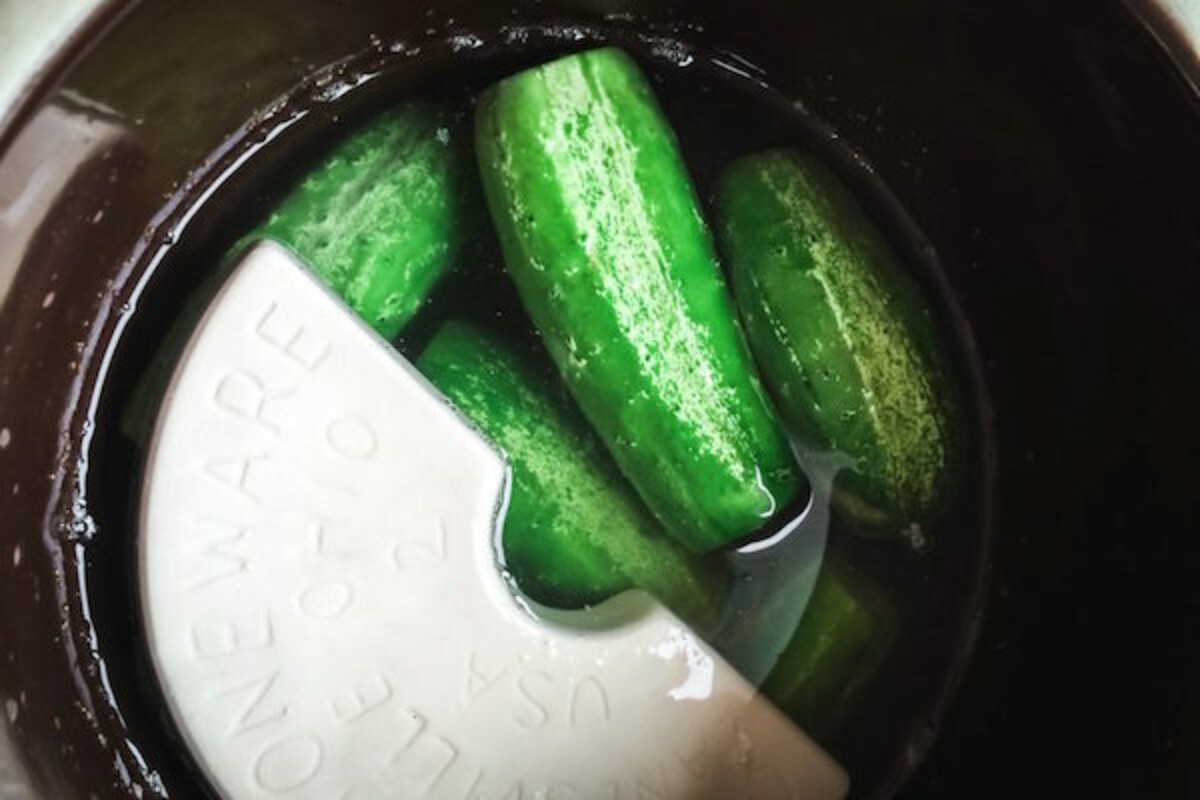
(This post is a contribution by Melissa Keyser)
My dad hates cucumbers. So much hate we couldn’t even have them in the house, he even detested the smell. So as a result, I didn’t eat many of them growing up.
But when I started living on my own and cooking seasonally, I’d pick cucumbers up at the farmers market, enjoying them sliced with a bit of salt or grating into yogurt as a dip.
My dad, however, was fine with pickles. My mom would often buy sliced dill pickles from the grocery store, the ones that came in the glass jar, that you fish out with a fork. I just assumed that all pickles were like this.
When I had my own garden, cucumbers were one of the first things I was excited to grow. And like all things when I have too many to eat fresh, I searched for creative ways to use them. I started with canning dill pickles, making ones similar to the store-bought pickles of my childhood (which were never quite as good…).
Then, I learned about lacto-fermented pickles.
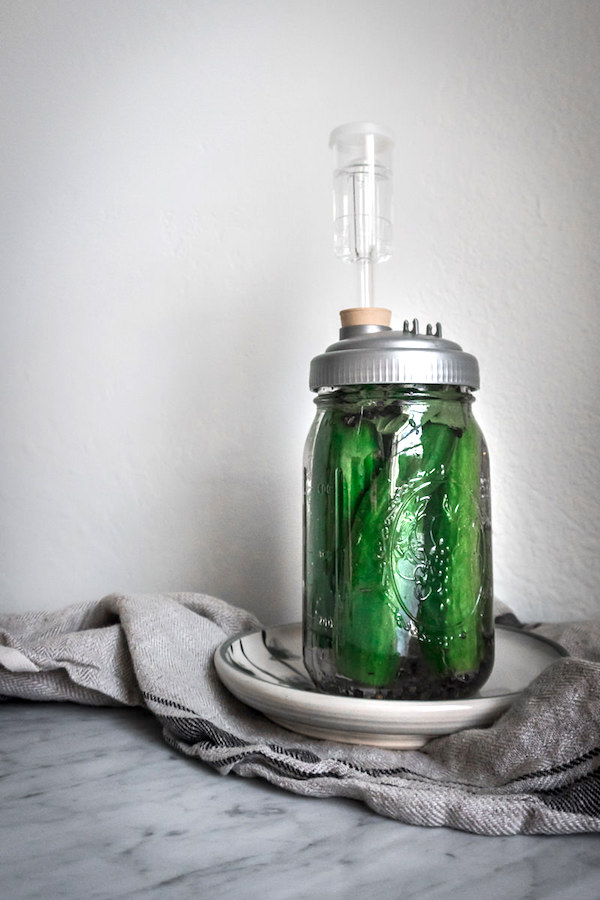
What are Lacto-Fermented Pickles?
Also known as “real pickles”, or sour pickles, lacto-fermented pickles rely on naturally occurring lactobacillus bacteria to ferment, or pickle, the cucumbers. The benefits of eating fermented foods are well known- they nourish our digestive system with living cultures, which help break down food and help the body absorb the food’s nutrients. Fermentation was also an important form of food preservation for our ancestors, saving nutrient-rich foods during their peak season to eat during the winter.
Fermented dill pickles are not the same as vinegar or refrigerator pickles. Vinegar pickles, or pickles that you would be canning, use vinegar to flavor the cucumbers, and heat sterilizes the food, killing any beneficial bacteria.
While tasty, they do not have probiotic benefits. If you’re looking for probiotic benefits, eat at least a quarter cup of pickles a day, or other fermented foods.

Fermented Pickles are a Perfect Project for Small Harvests
During the cucumber season, I enjoy eating fresh cucumbers, but most of them are fermented as dill pickles. Because I have a small garden and only a few plants, I have a steady stream of the fruit, but not always enough at one time to preserve by canning. I can easily ferment a jar of just a few pickles, while a canning batch requires much more.
Plus, I don’t have to haul out the canning pot and having to deal with sticky, hot vinegar! And, they are better for your body and nourish your digestive system!
Choose the Right Cucumber for your Fermented Pickles
Not all cucumbers are considered equal when it comes to fermenting pickles. You want to use varieties that have been bred and selected specifically for pickling. Skip the English hothouse cucumbers or the big, uniform slicing guys at the grocery store.
The popular lemon cucumber, or my favorite slicing, Dragon’s Egg, also won’t work. Instead, seek out the smaller pickling cucumbers at the farmer’s market. Or, if you grow your own, you’ll find lots of varieties specifically for pickling.
In the past, I’ve grown the Dar variety, but this year, I’m growing Muncher, and really loving them. They are doing great in my Central Valley heat, have smooth skin, and are also great as a fresh eating slicer and not at all bitter (double-duty cucumber, FTW!)
How to Make Lacto-Fermented Pickles
It’s easy to scale up or down the ingredients depending on how many cucumbers you have- the steps are the same if you have a half dozen or 2 dozen. Pickles have been known to be one of the more challenging vegetables to ferment, but follow these easy steps to make your own with no problems!
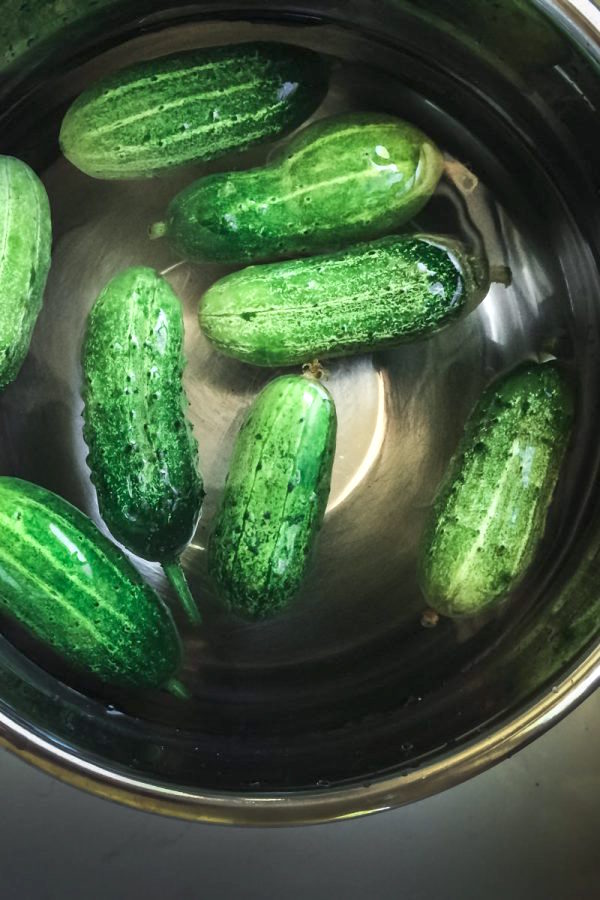
GATHER & WASH THE CUCUMBERS
Harvest or purchase fresh pickling cucumbers from a local farm. Pick ones that are about 4- 6″ long. Don’t bother with grocery store cucumbers, they will likely be dried out and result in hallow pickles. Ideally, harvest them the same day you will be fermenting.
Rinse, but don’t peel. At this point, it’s helpful to find a jar or crock that will hold your cucumbers, and see how they fit, so you know how much brine to make.
You’ll need to make a brine to cover the cucumbers, so make note of how much you’ll need to fill the jar. I like using mason jars as the shoulders help keep the pickles under the brine. You can also use a crock and weights to keep the cucumbers submerged.
Place the cucumbers in a bowl of ice water while you finish the remaining steps. This water bath is optional but is said to make crisper pickles. I sometimes do this, sometimes not, depending on my timing.
MAKE THE BRINE
This is the saltwater solution that the cucumbers will be covered by. These steps are for a half-sour dill pickle, and you want a 3.5% brine solution. This comes out to be about 2 tablespoons of salt per quart (4 cups) of water.
Make enough brine so they will completely submerge your cucumbers. If you are doing 8 or so pickles, in a half gallon jar, you’ll probably need 4 cups of brine.
Add the salt to a bowl or a jar with the water. Stir to dissolve, then wait until completely cold. I put mine in the fridge while I prep everything else.
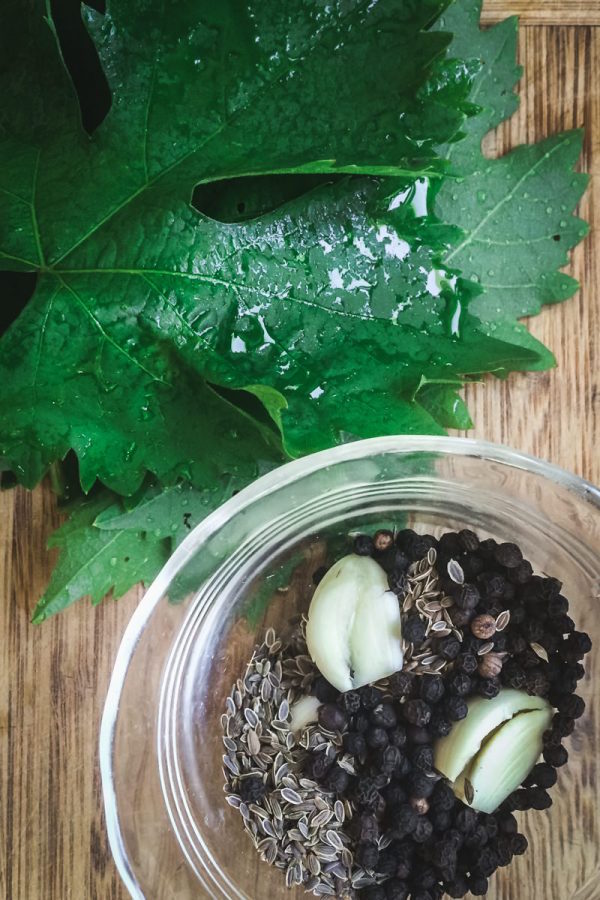
GATHER YOUR SPICES
This can easily be customized based on your taste preferences, but the standard players are dill, peppercorns, and garlic. Bay leaf and mustard are other common additions. Play around, add more or less of what you like! If you like it spicy, add horseradish or dried chili pepper.
The grape leaves may seem like an odd ingredient, but the tannins in the leaves help keep the pickles crispy. I have read that oak leaves or a tablespoon of tea leaves will also work, but I haven’t tried it.
For an 8 pickle batch, measure or eye-ball out:
- 2 teaspoons peppercorns
- 2 dill flower heads OR 2 Tablespoons dill seed
- 5-6 cloves of whole garlic, peeled and gently smashed
- 1 bay leaf (optional)
- 1 Tablespoons mustard seeds (optional)
- a handful of unsprayed grape leaves, rinsed
Plus, your brine– about 2 tablespoons of salt dissolved in 4 cups of water, as detailed above.
PREP THE CUCUMBERS
Take your nice cold cucumbers from the bowl of ice water, and cut a 1/4″ off of the blossom end. There is an enzyme in this area that results in mushy cucumbers, so it needs to be removed. If you can’t tell which end is the blossom end, just cut a slice off both ends.
LAYER THE JAR AND LET FERMENT
Put your grape leaves at the bottom of your jar, then the garlic and spices. Pack the cucumbers in, and pour the brine over the cucumbers.
If your cucumbers don’t reach to the shoulder of the jar, and are floating at the surface, use a smaller mason jar filled with water or a plastic bag filled with water to weigh down the cucumbers to submerge them. Spices will float to the surface, and that’s ok, but you want the cucumbers under the water level.
Add your weights if needed, your airlock (or your weights and cover if you use an open crock) then set to ferment! If your house is anything like mine, it’s likely you’re fermenting over 77 degrees.
In this case, your pickles will be done in 3-5 days. Ideally, you’d be fermenting at a cooler temperature and would take 7-10 days. As they ferment, the skin color changes from bright green to an olive green, interiors change from white to translucent.
The picture below shows a batch at 5 days, and a brand new batch. Don’t be alarmed if you see the water go cloudy or if you get mold at the top (you can just scrape that off).
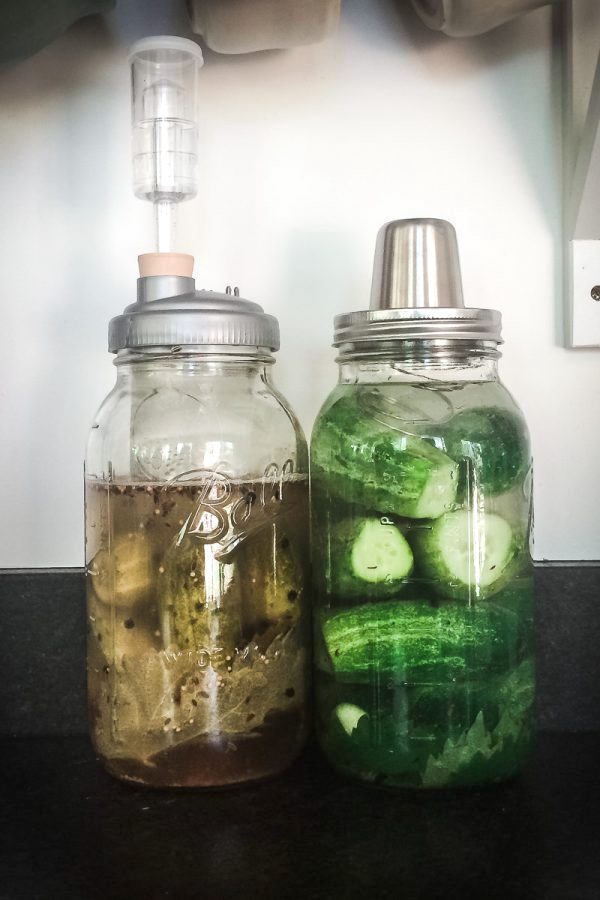
When your time is up, pour or spoon out any mold, and then store it in the fridge or another spot that stays below 60 degrees.
Give the pickle a rinse before eating, and enjoy!!!
Fermented Pickle Kit
If you’re the kind of person that works well from a kit with instructions, cultures for health has a fermented pickle-making kit that includes everything you need to make homemade Lacto-fermented pickles (except the cucumbers, of course).
The kit also comes with recipe cards not only for Lacto-fermented pickles but also homemade sauerkraut, kimchi, fermented hot sauce, and other fermented vegetables.
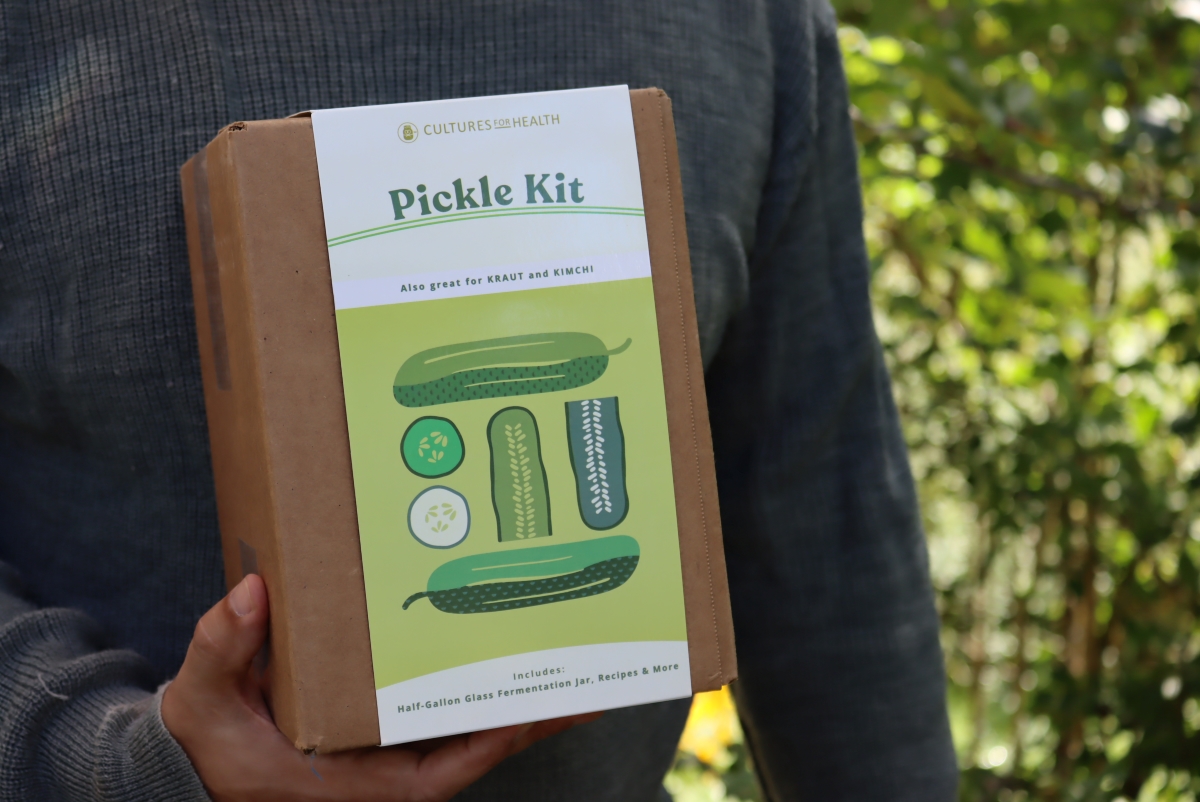
Lacto-Fermentation Recipes
Looking for more ways to keep your fermentation crock bubbling?
- How to Make Sauerkraut
- How to Make Sauerkraut in a Crock
- Lacto-Fermented Berries
- Fermented Turmeric ~ Natural Anti-Inflammatory
- Beginners Guide To Lacto-Fermentation
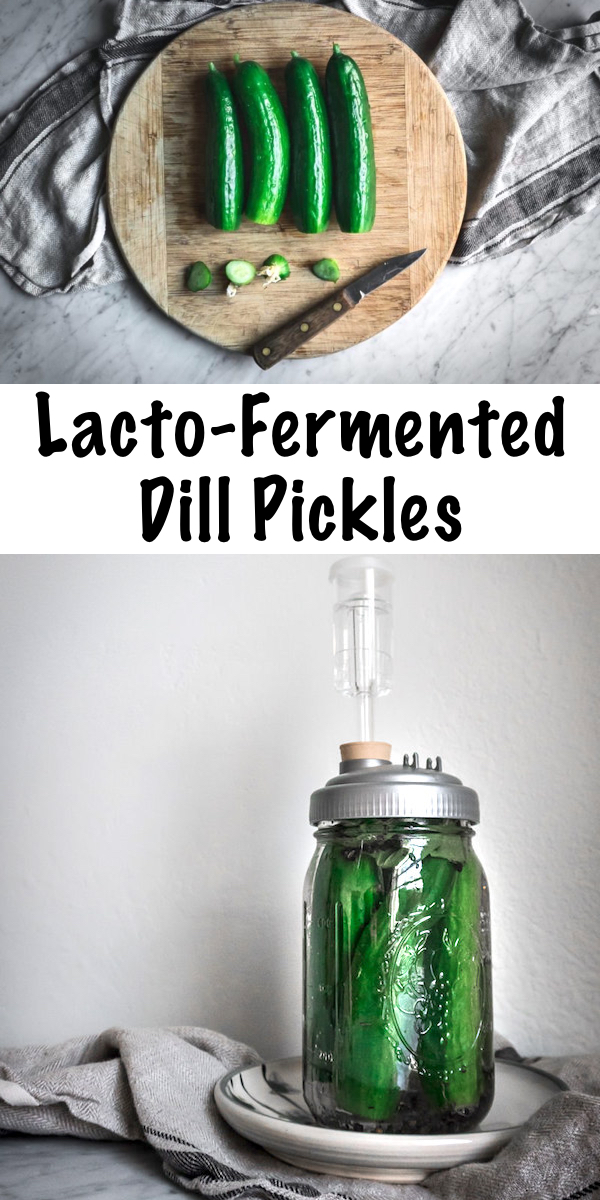
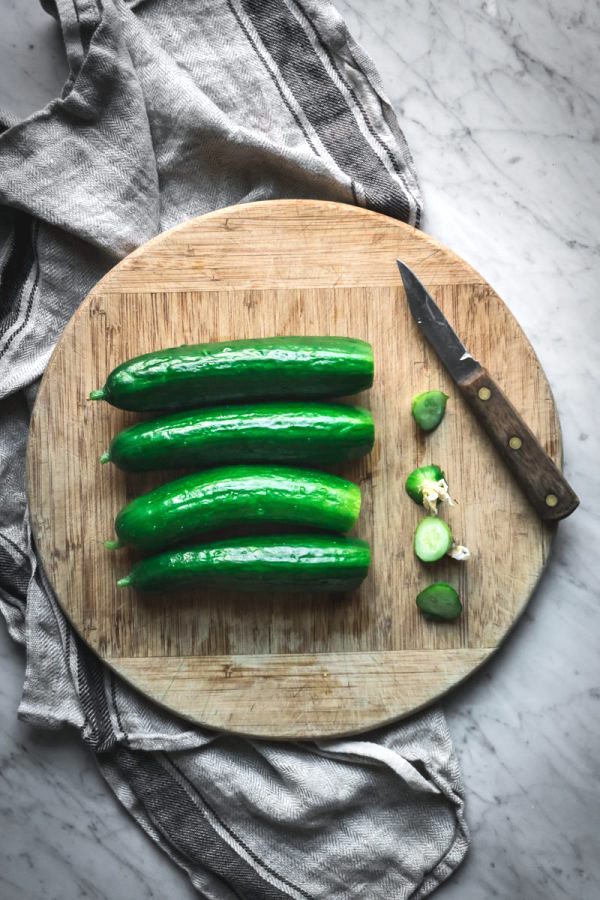
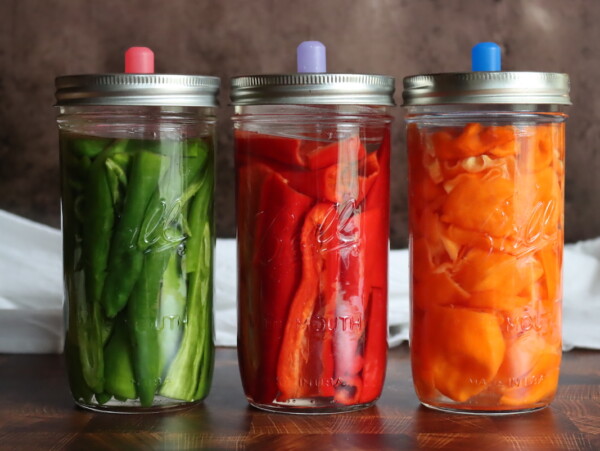
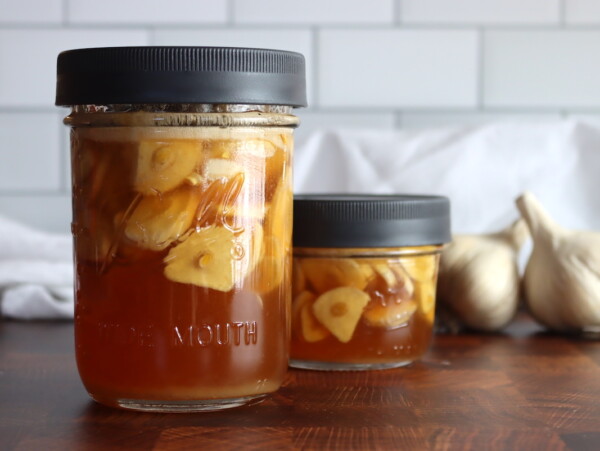
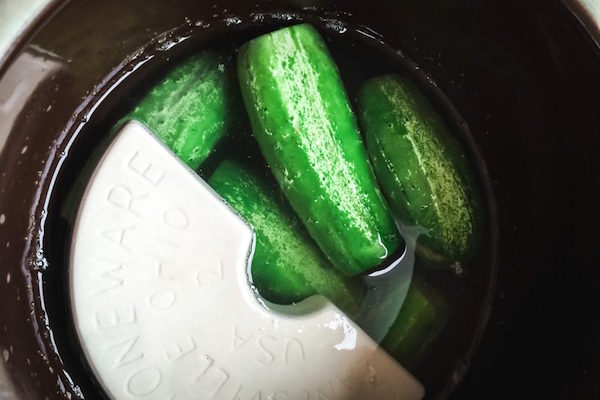
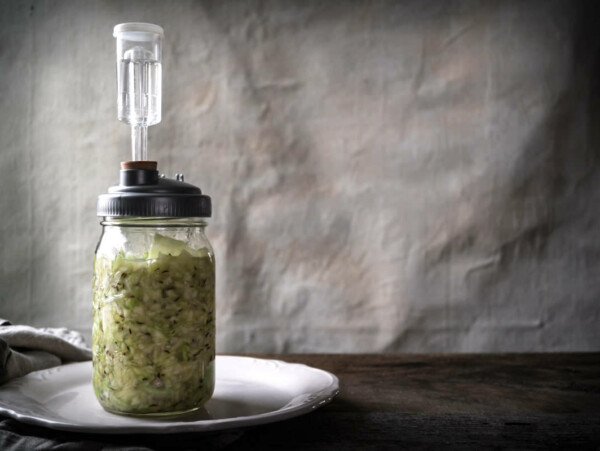










Can a cabbage leaf be used to keep the pickles submerged?
Yes, that would work just fine.
I have successfully used horseradish leaves for tanin in my lacto pickles. In a half gallon jar I add 5 garlic cloves (sliced in half) 3 allspice balls, a good pinch of red pepper flakes, 2 tablespoons of dill seed (or two big heads fresh) a teaspoon of whole mustard, and 2 banana peppers sliced in half, then the rest whole pickles that I slice a tad down the middle (ferments faster) , always comes out AMAZING!
That’s great. Thanks for sharing.
In the old days jugs of pickles were kept on the counter at the General Store. Before that, barrels of pickles were stored in folks’ cold rooms or basements. So, clearly, not refrigerated in either case. Which implies pickles can be kept on the (cool) shelf. And if we’re thinking in terms of self-reliance and self-reliance includes potentially being without power for an extended period, that’s what we need to be able to do to preserve a harvest.
I just made my first batch of pickles following the guidance here. I filled a 5 Liter fermenting crock with whole cucumbers, and a half gallon jar with spears (quartered cucumbers). Kept them submerged during pickling. Both pickled beautifully, although the spears are mushier, the whole pickles almost not at all. I used tea leaves for the tannin; I think I’ll try more net time, and also experiment with grape and currant leaves, having both on property.
My fermenting crock has a water lip to serve as a barrier to exchange of air and gas. The jar does not have the fermenting cap with N-shaped water trap. The spices and herbs that floated to the top of the brine in the jar molded, but not in the crock. However, that mold is not harmful to humans (according to the teaching of my mother, raised during the Depression); I believe it is the same mold from which penicillin was derived (or a cousin to it). If any pickle has picked up brine while I am extracting it, I’ve just rinsed it off, although I’m not convinced it’s necessary, and I haven’t been thorough about it.
I have been eating pickles from both containers, kept on the shelf, for over 3 weeks now. The jar of spears developed quite a bit of surface mold, and it began to look like some was forming submerged within the brine, so I just today decided to rinse the remaining spears and store them in a jar in the refrigerator. I thought about making a new brine for them but I’m curious to see how they hold up refrigerated with no brine. It’s an experiment.
From repeatedly opening the fermenting crock to extract whole cucumbers – which I prefer because they are overall more crispy, and it’s just luscious to bite into a big, juicy, flavorful pickle – finally some mold has begun to form. I’m sure that’s partly because I stick my fingers in to fish out a pickle, but I expect some mold would form in any event from the periodic opening to the air.
I’m wondering what they used to do in the old days. Did they have mold forming in the barrels that they just didn’t worry about? I think they would have had to take that route. And the jars of pickles on General Store counters: did they also just put up with the mold? Or did they refresh the brine periodically to make a mold-free visual?
So far, I don’t have an answer. But I have had no ill effects from the mold, which argues my mother was correct to not worry. I suspect that the old ways of storing food, including the beneficial molds that formed, fortify our guts rather than harm them, given that our species developed while eating such things.
Hi – Thanks for the recipe. I have my cucumbers busy fermenting away at the moment, question is that once they are “ready”, do I just leave them fermenting (in the crock) or should we removed and refrigerate? If we do this I would assume we keep them in the brine in the fridge.
Thanks in advance!
Greg
Once they are ready, you definitely want to move them to the refrigerator or cold storage. If you don’t they will continue to ferment. You will want to keep them in the brine.
Thanks so much for the reply. Have moved them crockpot and all to the fridge. They look great but I won’t try one until they are cold. Cheers.
Fantastic. Let us know how they turn out.
I took a zoom class that also was about this topic, and they suggested currant leaves for the tannins. i’m going to try it since I just happened to buy a black currant bush this year!
That sounds like a great idea. Thanks for sharing.
What kind of salt do you use?
You can use any good quality salt that is pure salt with no additives. I personally like to use a mineral salt like Redmond’s Real Salt for all of my ferments.
Hi Ashley!
Can you can these after the fermentation process?? And if not how long do they last in the refrigerator?? Most fermented pickle recipes I have seen take up to six weeks? Thanks so much, Jennifer
Canning would kill the good bacteria in the ferment, unfortunately. However, lacto-fermented veggies can be stored safely for months refrigerated.
Why do you say give the pickle a rinse before eating?
personal preference
Hi, what if one of my cucumber is floating on the surface? Will it go bad? I guess I’ll see soong enough, I’ll open the jar in 2 days 😛
They’ll all float given enough time, the lacto fermentation bacteria are creating CO2 in there. That’s one reason it’s important to have some kind of fermentation weight to keep everything submerged. Anything exposed to the air is likely to mold.
Nice article. I just fermented 6 pints today, I halved then quartered them, since they were so big. Some with granulated garlic, home dried sili hot peppers. I Always use bay leaf for tannins. Throw in a piece or 2 of white radish if you like horseradish flavor. Fermentation is done in 4 days in the Philippines homey🤙
Sounds wonderful!
The middle of the pickle spears were very mushy after 4 days. The rind was still crunchy. Any ideas on what I can do to fix this issue? Am I using improper cucs? They were fresh and hard to start. So disappointed🙄
How big were they?